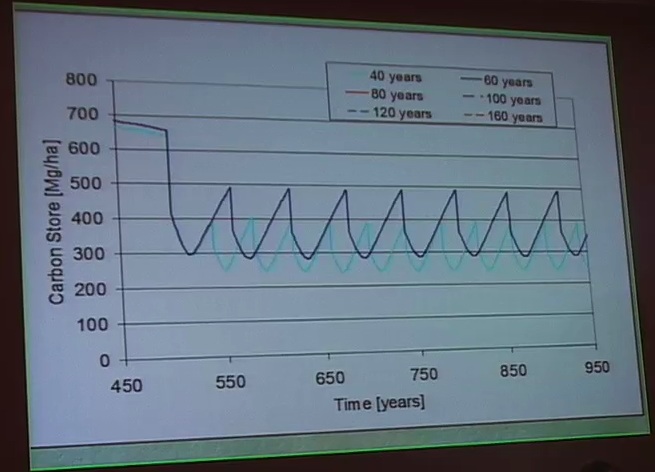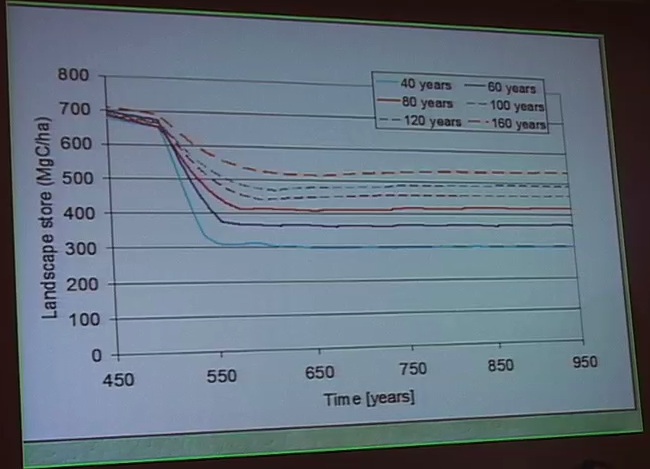Clearcutting the Climate Conference
Saturday, January 26, 2008
10 am – 5 pm
University of Oregon
Eugene, Oregon
Lawrence 177 (School of Architecture)
Burning fossil fuels - petroleum, coal and natural gas - is not the only cause of global warming. Clearcutting forests also disrupts the climate. Join expert scientists and environmental leaders for a groundbreaking one day conference to bring together citizens concerned about climate change and about forest protection. |
- speakers (morning and afternoon)
- afternoon discussion workshops
- conference organizers
- co-sponsors
- a model of relocalization
- disclaimer
| Clearcutting the Climate videos (partial list) |
graphics from Professor Olga Krankina showing carbon storage in Douglas Fir forest after a clearcut. Even long rotation forestry cannot capture the original forest's carbon storage. Rotting stumps emit stored carbon for decades after logging in greater levels than the regrowth can absorb. Tree plantations also store much less carbon in the soil than old growth.
The first graphic shows carbon storage for an individual forest plot, the graphic below shows the carbon storage on a landscape level (many cuts averaged together). Forty year rotation clearcuts store less than half the carbon of old growth. Even hundred year rotations (rarely done by timber companies) store much less carbon than the original forest.
|
3. If allowed to mature, Pacific Northwest forests can capture and store more carbon per acre than any other major forest type on the planet. Old growth forests in western Oregon can store over 1,000 tons CO2-e per acre.
The Intergovernmental Panel and Climate Change (IPCC) has produced carbon storage metrics for 13 forest biomes within four global forest types: tropical, subtropical, temperate, and boreal. Pacific Northwest forests are part of the cool temperate moist biome, which is the most carbon rich biome on Earth with mean storage of 233 tons carbon per hectare (tC/ha).18
This biome "default" value, however, includes both cutover and old growth lands and various forest types. Old growth forests in the Pacific Northwest store far more.
Forest carbon density in Oregon's ancient forests has been found to top 1,000 tC/ha. For example, throughout the H.J. Andrews Experimental Forests, Seidel et al. (2012) found mean carbon storage in old growth to be 724.5 tC/ha, with maximum values over 1,200 tC/ha. The mean value is equivalent to 1,076 tCO2-e per acre (Appendix N).19
Keynote Speakers (morning session):
Mark Harmon
Professor and Richardson Chair of Forest Science
Oregon State University, Corvallis, OregonCarbon Dioxide in the Atmosphere
As part of several greenhouse gases, carbon plays a critical role in regulating the surface temperature on earth. With the release of carbon dioxide through human activities, increasing concentrations are sufficient to warm the earth's surface temperature above that expected in natural cycles. Current concentrations and recent rates of increase exceed that observed in the last 420,000 years. Changes in energy source and uses as well as management of natural systems will be required to stablize and reduce carbon dioxide concentrations in the next 100 years.Olga Krankina
Assistant Professor, Sr. Research, Forest Management, Forest Ecology
Oregon State University, Corvallis, OregonForest management and mitigation of climate change:
in search of synergies
Can forests play a role in reducing the carbon footprint of Oregon's economy? Which forest and land management decisions promote carbon sequestration on land? We will examine different strategies for increasing carbon stores on land in comparison with other approaches to address climate change.
Panel: Forests and Climate (afternoon session):
Doug Heiken
Conservation and Restoration Coordinator
Oregon Wild, formerly Oregon Natural Resources Council (ONRC)
Eugene, OregonMyths and Facts about Forests and Global Warming
My talk will focus on the myths that surround the role of forests in the global carbon cycle and climate regulation. I will attempt to debunk some of the misinformation that is promoted by the timber industry and their allies.Pat Rasmussen
World Temperate Rainforest Network
Peshastin, Washington
Alder Fuller
Euglena Academy, Eugene, Oregon
Lance Olsen
former president, Great Bear Foundation
Missoula, Montana (via video link)
[affiliations for identification purposes only]
Afternoon Discussions:
- how the climate and forest protection movements can work together
- real and false solutions for the climate / forest crises
Conclusion: Workshop summaries and Next Steps
Tim Hermach
Native Forest Council, Eugene, Oregon
Organizers:
Cascadia's Ecosystem Advocates
Native Forest Council [defunct]
UO Survival Center
Co-sponsored by:
Climate Crisis Working Group
Helios Resource Network
Lane County Energy Round Up
Lost Valley Educational Center
Pitchfork Rebellion
Vision for Intact Ecosystems and Watersheds (VIEW)
A model of relocalization:
a bioregional conference with global implications
This conference is not flying in anyone from anywhere. We seek to conserve energy, prevent pollution, and be a model of relocalizing actions. The Willamette Valley - and the Pacific Northwest - have tremendous local talents that do not require importing speakers from distant places.
Why this conference is not "carbon neutral"
We hope that the positive impact of the conference offsets the consumption of non-renewable fossil fuels, but Clearcutting the Climate is not pretending that our energy impact can be "carbon neutral." The electricity used as part of the preparation for this conference was a mix of coal, hydro-electric, natural gas, nuclear, wind and solar (in order of greatest to least). Some petroleum was used by some of the organizers, some of the speakers and some of the audience. This website is hosted by a computer company that is largely powered by burning coal and nuclear energy. The main computer used to write this website has some of its electricity directly supplied by photovoltaic solar panels, but in the wintertime most of its electricity is just from the electric power grid with its mix of electrical generation sources.
Carbon neutrality and carbon offsets are propaganda exercises that provide the illusion that promoting efficiency and renewable energy can somehow undo the impact of burning stored solar energy from the Carboniferous era. No project - not even the best - can remove carbon from burned fossil fuels and sequester it back into the crust of the Earth. Coping with the ecological crisis would require honesty about our impact - and carbon credits or offsets are distractions that provide the illusion that we can burn finite, toxic energy sources without long term consequences.
For more about "carbon neutrality"
www.cheatneutral.com (parody website - no longer on line)
www.peakchoice.org/carbon-neutral.html (serious analysis)
disclaimer:
The speakers, organizers and co-sponsors do not necessarily agree with everything on this website. The science of forestry's contributions to climate change is complex and evolving. We support the precautionary principle to prevent irreversible damage to ecosystems and the atmosphere. We also support reduction of waste and overconsumption of forest resources.






